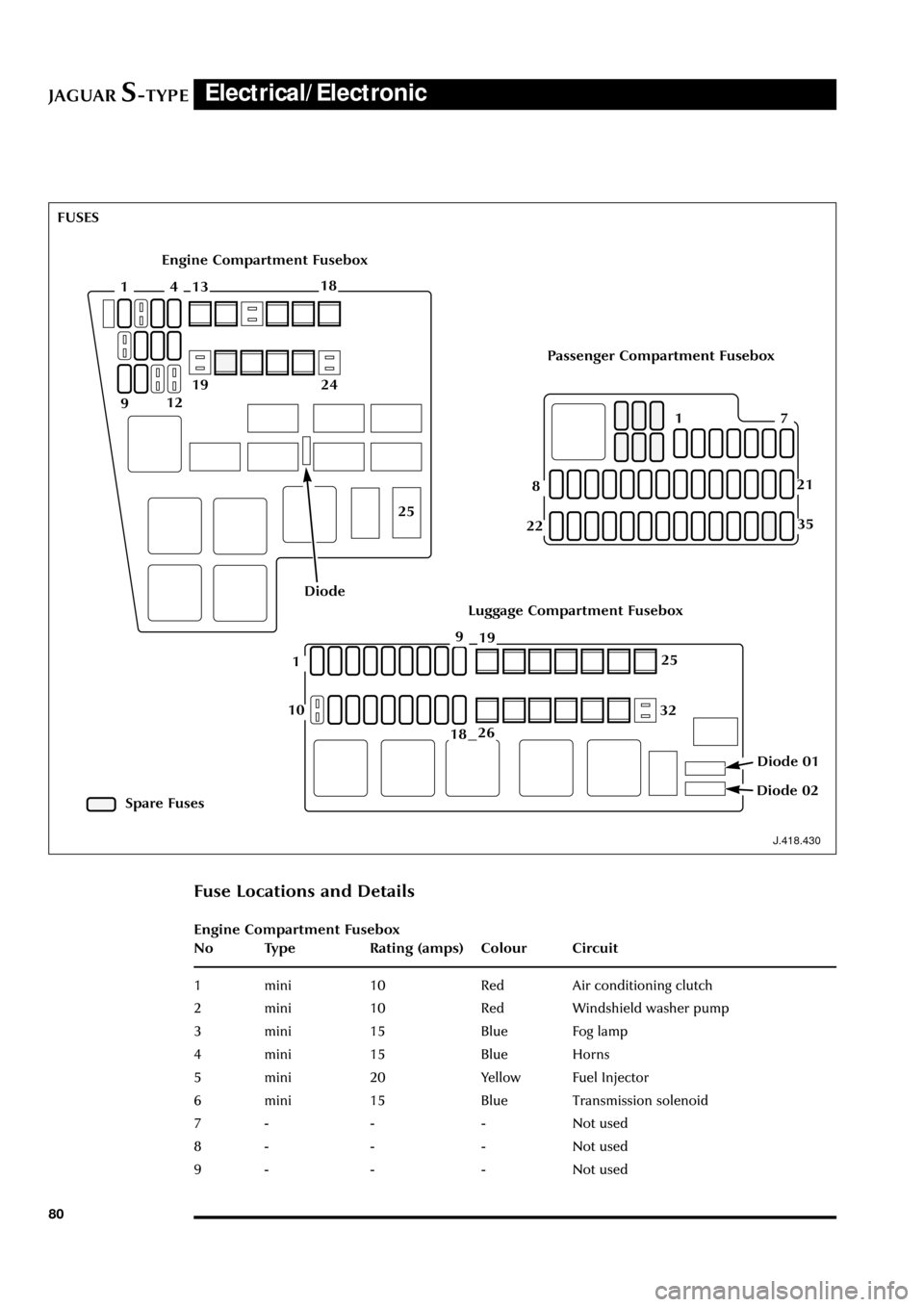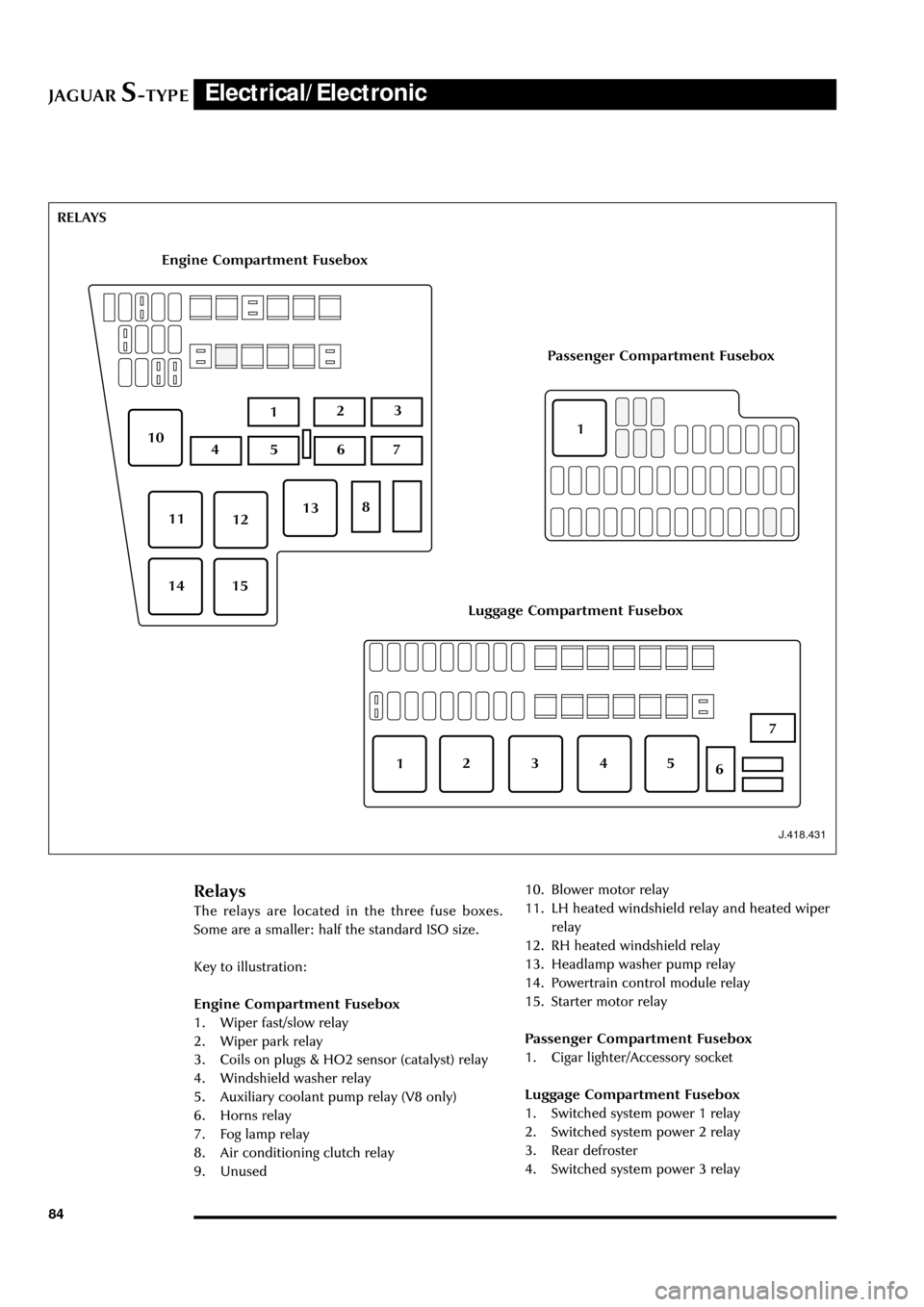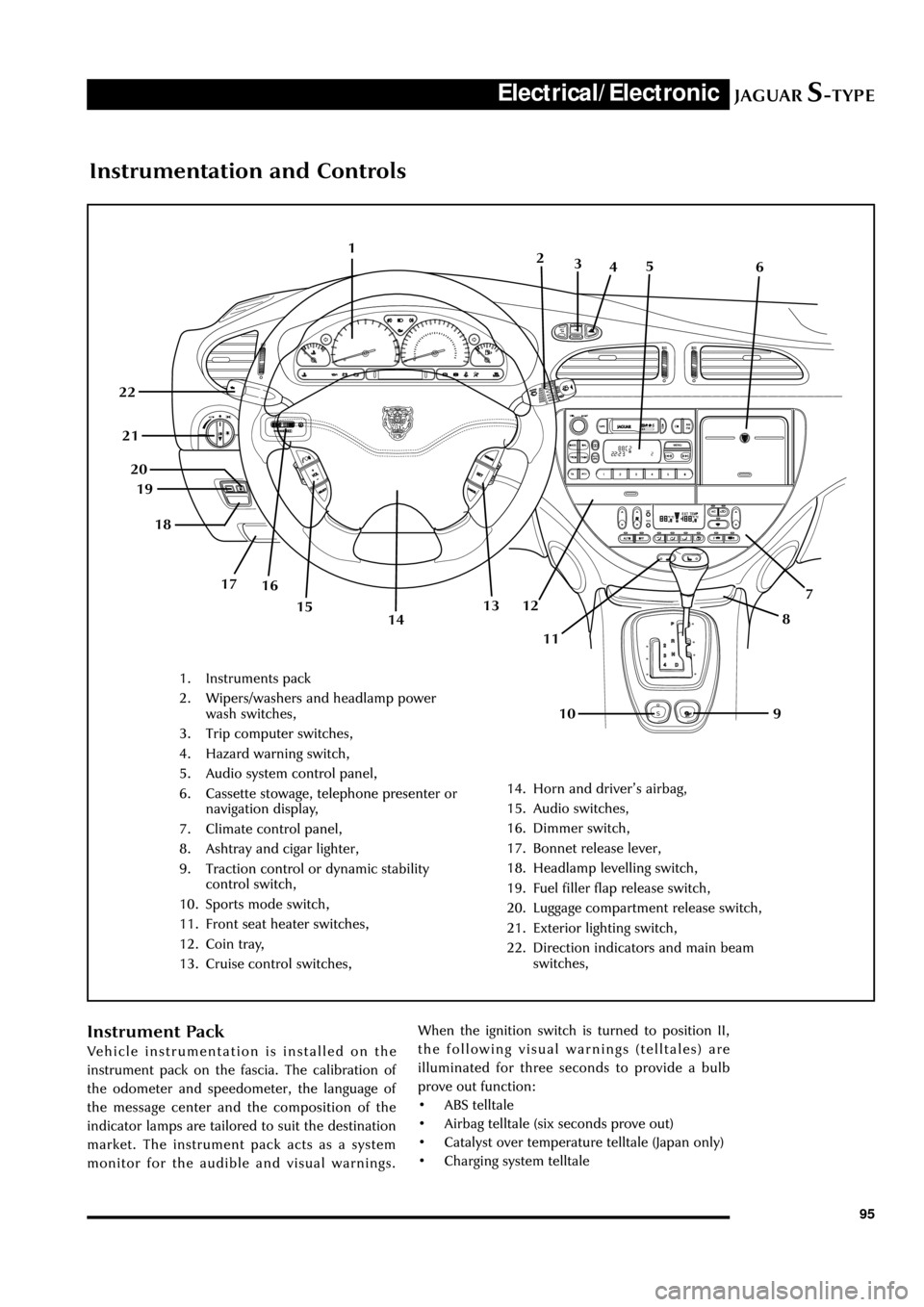horn JAGUAR S TYPE 2005 1.G Technical Guide Update
[x] Cancel search | Manufacturer: JAGUAR, Model Year: 2005, Model line: S TYPE, Model: JAGUAR S TYPE 2005 1.GPages: 133, PDF Size: 3.48 MB
Page 64 of 133

JAGUARS-TYPEChassis
59
D.211.248
FRONT STEERING ARM requires a Service tool to assist removal. Low-
pressure hose connections are made using
Constant Tension (CT) clamps. Pinion hydraulic
connections are orientated with the bottom
connector low pressure with the longer nut, as
current vehicles.
The PAS fluid is for PAS only; it is not to be used
for transmissions. After manual filling, the system
must be bled using a vacuum pump to remove all
the air from the system to prevent system noises.
Fluid level is checked through a sight window on
the reservoir.
Components replaceable are complete pump,
steering rack, reservoir or hose assembly.
A non-serviceable 10-micron filter is located
within the reservoir to maintain fluid cleanliness
throughout the life of the vehicle. It is essential as
with all Jaguars that the system does not become
contaminated. Cap all ports on disassembly to
prevent contamination ingress. As with current
vehicles, the fluid and reservoir must be renewed
if any major component is replaced i.e. Rack,
pump or cooler.
The road wheels should be set straight ahead and
the steering wheel locked (using service tool
F7LC-3F732-BF) when removal and assembly of
the steering gear or intermediate shaft is required.
This is necessary to prevent damage to the air bag
clock spring within the steering upper column
assembly. The intermediate shaft can only be
assembled to its mating components in one
location. Steering wheel alignment can only be
achieved by adjustment at the tie-rods. A
dimensional check of the steering rack position
may be necessary to verify rack centre.
Steering Column
The steering column assembly is completely new
and uses no parts from previous Jaguar
assemblies:
¥ Construction of the upper column assembly is
based on the use of aluminium extrusions and
castings.
¥ A two shaft lower column assembly is used.
¥ The electronically controlled steering lock, the
steering column lock module (SCLM), is a
physically separate component from the
ignition switch which is fascia mounted.
¥ The dynamic stability control (DSC) steering
wheel position sensor is fitted to the upper
column assembly.
Steering Wheel
The steering wheel consists of a magnesium
armature with a central steel insert. The steering
column and wheel insert are splined with a flat so
that the wheel can only be fitted in one position.
Any misalignment of the steering wheel is
corrected by adjusting the tie rods. The splined
fitting also has a locking taper which requires the
use of a 2 legged puller to remove the wheel.
The steering wheel incorporates the the airbag
module, horn mechanism and the optional cruise
control and audio/phone switches.
Page 85 of 133

JAGUARS-TYPEElectrical/Electronic
80
J.418.430
Fuse Locations and Details
Engine Compartment Fusebox
No Type Rating (amps) Colour Circuit
1 mini 10 Red Air conditioning clutch
2 mini 10 Red Windshield washer pump
3 mini 15 Blue Fog lamp
4 mini 15 Blue Horns
5 mini 20 Yellow Fuel Injector
6 mini 15 Blue Transmission solenoid
7 - - - Not used
8 - - - Not used
9 - - - Not used
Engine Compartment Fusebox
Luggage Compartment Fusebox
Passenger Compartment Fusebox
Spare Fuses FUSES
411318
912
2419
25
Diode
71
8
22
21
251
18
10
9
32
26
19
Diode 02
Diode 01
35
Page 86 of 133

JAGUARS-TYPEElectrical/Electronic
81 No Type Rating (amps) Colour Circuit
10 - - - Not used
11 mini 15 Blue HO2 sensor (catalyst)
12 mini 10 Red Coil on plug
13 cartridge 40 or 30 Green or Pink RH heated windshield or heated wiper
park (where fitted)
14 - - - Not used
15 cartridge 40 Green LH heated windshield
16 cartridge 30 Pink Blower motor
17 - - - Not used
18 cartridge 40 Green Powertrain control module (PCM)
19 - - - Not used
20 - - - Not used
21 cartridge 30 Pink Starter solenoid
22 cartridge 30 Pink ABS motor
23 cartridge 20 Blue Wiper motor
24 cartridge 30 Pink Head lamp washer pump
25 cartridge 80 - Cooling fan motor
Diode 1 PCM
Passenger Compartment Fusebox
No Type Rating (amps) Colour Circuit
1 mini 5 Brown Starter relay coil via Park/Neutral switch
2 mini 5 Brown Radio
3 mini 5 Brown ABS/DSC module
4 mini 5 Brown PCM relay coil, instrument pack, RECM,
fuel pump relay, transit relay
5 mini 5 Brown Autolamp sensor, heated seat module
switch & overdrive cancel switch RSM, BSI
6 mini 10 Red OBDII
7 mini 5 Brown DDCM, DSCM, PCM, Anti-theft LED,
security horn, power mirror
8 mini 5 Brown Right-front direction indicators, side
repeaters, side markers, park lights
9 mini 10 Red Right-front low beam headlamp
10 mini 5 Brown Left-front direction indicators side
repeaters, side markers, park lamps
11 mini 10 Red Left-front main beam lamp
12 mini 10 Red Headlamp levelling, ABS/DSC module
13 mini 5 Brown Instrument pack
14 mini 10 Red RCM, Dual Automatic Temperature
Control (DATC) module
Page 89 of 133

JAGUARS-TYPEElectrical/Electronic
84
J.418.431
Engine Compartment Fusebox
Luggage Compartment Fusebox
Passenger Compartment Fusebox
Relays
The relays are located in the three fuse boxes.
Some are a smaller: half the standard ISO size.
Key to illustration:
Engine Compartment Fusebox
1. Wiper fast/slow relay
2. Wiper park relay
3. Coils on plugs & HO2 sensor (catalyst) relay
4. Windshield washer relay
5. Auxiliary coolant pump relay (V8 only)
6. Horns relay
7. Fog lamp relay
8. Air conditioning clutch relay
9. Unused10. Blower motor relay
11. LH heated windshield relay and heated wiper
relay
12. RH heated windshield relay
13. Headlamp washer pump relay
14. Powertrain control module relay
15. Starter motor relay
Passenger Compartment Fusebox
1. Cigar lighter/Accessory socket
Luggage Compartment Fusebox
1. Switched system power 1 relay
2. Switched system power 2 relay
3. Rear defroster
4. Switched system power 3 relay RELAYS
213
7
13
510
1211
1514
64
8
213
7
564
1
Page 100 of 133

JAGUARS-TYPEElectrical/Electronic
95
Instrumentation and Controls
1. Instruments pack
2. Wipers/washers and headlamp power
wash switches,
3. Trip computer switches,
4. Hazard warning switch,
5. Audio system control panel,
6. Cassette stowage, telephone presenter or
navigation display,
7. Climate control panel,
8. Ashtray and cigar lighter,
9. Traction control or dynamic stability
control switch,
10. Sports mode switch,
11. Front seat heater switches,
12. Coin tray,
13. Cruise control switches,
14. Horn and driverÕs airbag,
15. Audio switches,
16. Dimmer switch,
17. Bonnet release lever,
18. Headlamp levelling switch,
19. Fuel filler flap release switch,
20. Luggage compartment release switch,
21. Exterior lighting switch,
22. Direction indicators and main beam
switches,
1
7
8
9 10 11 12 13 19
16 17 18 20 21 22
142
3
45
6
15
Instrument Pack
Vehicle instrumentation is installed on the
instrument pack on the fascia. The calibration of
the odometer and speedometer, the language of
the message center and the composition of the
indicator lamps are tailored to suit the destination
market. The instrument pack acts as a system
monitor for the audible and visual warnings.When the ignition switch is turned to position II,
the following visual warnings (telltales) are
illuminated for three seconds to provide a bulb
prove out function:
¥ ABS telltale
¥ Airbag telltale (six seconds prove out)
¥ Catalyst over temperature telltale (Japan only)
¥ Charging system telltale
Page 113 of 133

JAGUARS-TYPEElectrical/Electronic
108
Security and Locking Systems
Introduction
The following security and locking features are
available but vary by market or options:
¥ Key barrel on driverÕs side only
¥ Encrypted engine immobilization by ignition
key transponder
¥ Radio frequency remote fob
¥ Central locking by key and remote fob
¥ Double locking (not in North America, Japan,
Taiwan)
¥ Drive away door locking
¥ Mechanical child locks on rear doors
¥ Perimeter alarm of doors, bonnet, trunk
¥ Intrusion sensing, ultrasonically sensed (not
in North America, Japan, Taiwan)
¥ Inclination (tilt) sensing (Dealer fit accessory)
¥ Panic alarm, fob operated (certain markets)
¥ Trunk lock isolate (valet lockout, see page
107) - North America only
¥ Electro/mechanical steering column lock
The following convenience features are included
either as standard or optional features:
¥ Remote fob operated driverÕs seat, door
mirrors and steering column memory recall
(two memories)
¥ Remote fob operated trunk lid release
¥ Key operated global close (sliding roof and all
windows)
¥ Key and fob remote-operated global open
(sliding roof and all windows)
¥ Trunk lid and fuel flap interior release buttons
¥ Trunk release button in trunk plinth
¥ Emergency key lock barrel under trunk plinth.
System Description
The security system is controlled by a driver door
control module (DDCM). When activated
unauthorized entry in to the vehicle is detected by
the courtesy lamp switches. When the alarm is
triggered, the system flashes the turn signal lamps
and sounds the alarm system horns.
The passive anti-theft system (PATS) is a feature to
prevent the vehicle being driven away by an
unauthorized person. The PATS system consists of
electronically coded keys, a transceiver and is
controlled by the Instrument Pack. When the
ignition is switched to position ÔIIÕ, the transceiver
energises the ignition key to read its electroniccode that is transmitted back. If the read code
equals a stored code in the control module, the
steering column is unlocked and the powertrain
control module (PCM) will let the engine start.
Otherwise, starting of the engine is disabled
(through the starter disable relay and the PCM).
The security indicator LED provides the driver
with the status of the PATS or security system. If
the security system is armed the light will flash
when the ignition is switched OFF. The PATS light
will illuminate when the key is inserted into the
ignition lock and turned to position ÔIIÕ. It will stay
illuminated until the system has carried out its test
on the key. If the system detects a fault, it will
flash the LED for 1 minute, and then flash out the
corresponding 2 digit fault code.
Security System Operating Components
Key to illustration on the following page:
1. Four button transmitter (North America/Rest
of the World)
2. Three button transmitter (Europe/Japan)
3. Trunk release switch
4. Trunk compartment actuator
5. Intrusion sensor
6. Door actuator
7. Driver door control module
8. Data link connector
9. General electronic control module
10. PATS transceiver module
11. Hood switch
12. Security LED
13. Horns
14. Security horn
15. Security sounder
16. Intrusion sensor
17. Rear electronic control module
Page 119 of 133

JAGUARS-TYPEElectrical/Electronic
114
Alarms and Audible Signals
Note:In certain markets, legislation prohibits the
use of audible confirmation signals. In such cases,
the sound source has been removed from the
system.
Audible Signals
An audible signal will sound when a door is
opened using a key if the vehicle has been armed
(Europe only). This mode can be cancelled within
15 seconds of opening the door, by disarming the
security system using the key-ring transmitter or
by switching the ignition to position ÔIIÕ.
Error Signal
The direction indicators will flash five times
whenever one of the following conditions is
present:
¥ If any door is open when an attempt to ÔarmÕ
the security system is made.
¥ The luggage compartment or the bonnet is
not properly closed when an attempt to ÔarmÕ
the security system is made.
¥ If there is an electrical failure within the
intrusion sensing system, if fitted, and an
attempt to ÔdisarmÕ the security system is
made.Full Alarm
Once armed, any of the following circumstances
will create a full alarm state and sound the horns
and flash the direction indicators:
¥ Opening a door, luggage compartment lid
(except with transmitter) or bonnet.
¥ Movement in the passenger area (if intrusion
sensors are fitted).
¥ Using a key in the ignition switch which is not
programmed to the vehicle.
¥ If the driverÕs door is opened with a key
(European markets only) after a 15 second
delay.
¥ If the inclination sensor (if fitted) is activated.
Intrusion Sensing (when fitted)
A further enhancement to the security system is
the addition of intrusion sensing. When the
vehicle is armed and double-locked, movement
within the vehicle interior will activate the alarm.
When the security system is disarmed the
intrusion sensors are also disarmed.
Panic Alarm (when fitted)
When in or near the vehicle, the alarm can be set
off to deter a possible offender. For this feature to
operate, the key must not be in the ignition
switch.
Pressing the panic button on the key-ring
transmitter will activate the ÔPanic AlarmÕ.
The Panic Alarm will sound for the normal full
alarm period. The alarm is stopped by putting the
key into the ignition switch and turning to position
ÔIIÕ.
The key-ring transmitter can be used to cancel the
Panic Alarm by pressing either the panic button or
the unlock button.
Inclination (tilt) Sensing Protection (Dealer
fit option)
This feature protects against unauthorized towing
away or jacking up. When the vehicle is double-
locked and armed, any tilting of the vehicle, such
as jacking or lifting, will activate the alarm.
Note:If the vehicle is being transported by road,
rail or sea, the vehicle should not be double-
locked. This prevents the inclination system from
being armed and sounding the alarm as the
vehicle pitches and rolls.
When the security system is disarmed the
inclination sensor is also disarmed.
D.418.232
INTRUSION SENSOR